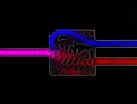(Press-News.org) Stanford electrical engineer Jelena Vuckovic wants to make computers faster and more efficient by reinventing how they send data back and forth between chips, where the work is done.
In computers today, data is pushed through wires as a stream of electrons. That takes a lot of power, which helps explain why laptops get so warm.
"Several years ago, my colleague David Miller carefully analyzed power consumption in computers, and the results were striking," said Vuckovic, referring to electrical engineering Professor David Miller. "Up to 80 percent of the microprocessor power is consumed by sending data over the wires - so called interconnects."
In a Nature Photonics article whose lead author is Stanford graduate student Alexander Piggott, Vuckovic, a professor of electrical engineering, and her team explain a process that could revolutionize computing by making it practical to use light instead of electricity to carry data inside computers.
Proven technology
In essence, the Stanford engineers want to miniaturize the proven technology of the Internet, which moves data by beaming photons of light through fiber optic threads.
"Optical transport uses far less energy than sending electrons through wires," Piggott said. "For chip-scale links, light can carry more than 20 times as much data."
Theoretically, this is doable because silicon is transparent to infrared light - the way glass is transparent to visible light. So wires could be replaced by optical interconnects: silicon structures designed to carry infrared light.
But so far, engineers have had to design optical interconnects one at a time. Given that thousands of such linkages are needed for each electronic system, optical data transport has remained impractical.
Now the Stanford engineers believe they've broken that bottleneck by inventing what they call an inverse design algorithm.
It works as the name suggests: the engineers specify what they want the optical circuit to do, and the software provides the details of how to fabricate a silicon structure to perform the task.
"We used the algorithm to design a working optical circuit and made several copies in our lab," Vuckovic said.
In addition to Piggott, the research team included former graduate student Jesse Lu (now at Google,) graduate student Jan Petykiewicz and postdoctoral scholars Thomas Babinec and Konstantinos Lagoudakis. As they reported in Nature Photonics, the devices functioned flawlessly despite tiny imperfections.
"Our manufacturing processes are not nearly as precise as those at commercial fabrication plants," Piggott said. "The fact that we could build devices this robust on our equipment tells us that this technology will be easy to mass-produce at state-of-the-art facilities."
The researchers envision many other potential applications for their inverse design algorithm, including high bandwidth optical communications, compact microscopy systems and ultra-secure quantum communications.
Light and silicon
The Stanford work relies on the well-known fact that infrared light will pass through silicon the way sunlight shines through glass.
And just as a prism bends visible light to reveal the rainbow, different silicon structures can bend infrared light in useful ways.
The Stanford algorithm designs silicon structures so slender that more than 20 of them could sit side-by-side inside the diameter of a human hair. These silicon interconnects can direct a specific frequency of infrared light to a specific location to replace a wire.
By loading data onto these frequencies, the Stanford algorithm can create switches or conduits or whatever else is required for the task.
The inverse design algorithm is what makes optical interconnects practical by describing how to create what amount to silicon prisms to bend infrared light.
Once the algorithm has calculated the proper shape for the task, engineers can use standard industrial processes to transfer that pattern onto a slice of silicon.
"Our structures look like Swiss cheese but they work better than anything we've seen before," Vuckovic said.
She and Piggott have made several different types of optical interconnects and they see no limits on what their inverse design algorithm can do.
In their Nature photonics paper, the Stanford authors note that the automation of large-scale circuit design enabled engineers to create today's sophisticated electronics.
By automating the process of designing optical interconnects, they feel that they have set the stage for the next generation of even faster and far more energy-efficient computers that use light rather than electricity for internal data transport.
INFORMATION:
A quantum system never relaxes. An isolated system (like a cloud of cold atoms trapped in optical grids) will endlessly oscillate between its different configurations without ever finding peace. In practice, these types of systems are unable to dissipate energy in any form. This is the exact opposite of what happens in classical physics, where the tendency to reach a state of equilibrium is such a fundamental drive that is has been made a fundamental law of physics, i.e., the second law of thermodynamics, which introduces the concept of entropy.
This profound difference ...
WASHINGTON -- People who earn a college degree before getting married are much less likely to become obese than those who graduate from college after getting married, according to a new study.
"People who get married before they earn a degree from a four-year college are about 65 percent more likely to later become obese than people who get married after college," said Richard Allen Miech, a research professor at the Institute for Social Research at the University of Michigan and the lead author of the study. "While a college degree has long been shown to be associated ...
A fifty-fold between-country difference in rates of paracetamol-induced acute liver failure that leads to liver transplant (ALFT) has been revealed by a study that compared patient data from seven countries at the request of the European Medicines Agency: France, Greece, Ireland, Italy, Netherlands, Portugal and the UK. Researchers discovered that this variation was even more pronounced on a per-capita basis, with a 200-fold difference in ALFT cases. Publishing these findings in the British Journal of Clinical Pharmacology, the authors call for further research to identify ...
Several genes have been lost from the Y chromosome in humans and other mammals, according to research published in the open access journal Genome Biology. The study shows that essential Y genes are rescued by relocating to other chromosomes, and it identifies a potentially important genetic factor in male infertility.
The Y chromosome is dramatically smaller than the X chromosome and has already lost nearly all of the 640 genes it once shared with the X chromosome.
An extreme example of genes disappearing from the Y chromosome can be found in the Ryukyu spiny rat, ...
In what they believe to be the first survey of its kind in the United States, researchers at NYU Langone Medical Center have found that as many as 6 percent of adult New Yorkers who get "inked" -- in other words, those who get a tattoo -- have experienced some form of tattoo-related rash, severe itching or swelling that lasted longer than four months and, in some cases, for many years.
"We were rather alarmed at the high rate of reported chronic complications tied to getting a tattoo," says senior study investigator and NYU Langone dermatologist Marie Leger, MD, PhD, ...
Researchers from the Netherlands have explored how 3D printing can be used to help treat type 1 diabetes in results presented today, Thursday 28 May, in IOP Publishing's journal Biofabrication.
The 3D printing technique, known as bioplotting, has taken researchers one step closer to being able to help patients who experience severe hypoglycaemic events, commonly known as 'hypos'- a problem that affects about a third of people with type 1 diabetes according to Diabetes UK.
The paper describes how clusters of specialized cells responsible for the production of insulin ...
This news release is available in French. Alzheimer's disease is the most common form of dementia, affecting over 44 million people worldwide. Inside the brain, Alzheimer's disease is characterized by loss of neurons, and presence of abnormal tangles and plaques in the brain. Dr. Graham Collingridge, recently recruited from Bristol (U.K.) to the University of Toronto, has found that molecules that are strongly associated with Alzheimer's disease are important players in a process called long-term depression (LTD). LTD is a process through which the strength of synapses, ...
This news release is available in French. Pain has both physical and emotional components. Anxiety is common in people suffering from chronic pain, and people with anxiety are more likely to suffer from chronic pain. Dr. Min Zhuo and his team at the University of Toronto have found the biological basis for this link in the connections between neurons in a brain region known as the anterior cingulate cortex (ACC). Better yet, they have identified a molecule that can reduce chronic pain-related anxiety. Dr. Zhuo's latest results were presented at the 9th Annual Canadian ...
A longhorned beetle's sexy scent might make a female perk up her antennae. But when the males of several species all smell the same, a female cannot choose by cologne alone.
For these beetles to find a mate of the right species, timing is everything, according to research from a University of Arizona-led team.
"We found that beetles that produce the same pheromone are active at different times of day - and that beetles that are active at the same time of day produce different pheromones," said lead author Robert F. Mitchell, a UA research associate in the department ...
Fast Facts
People with schizophrenia often suffer from cognitive difficulties.
Transcranial direct current stimulation of the brain is widely considered safe and is being studied as a treatment for depression.
In a Johns Hopkins study of people with schizophrenia, transcranial direct current stimulation led to improvements in short-term memory.
Lightly stimulating the brain with electricity may improve short-term memory in people with schizophrenia, according to a new study by researchers at the Johns Hopkins University School of Medicine.
The ...

